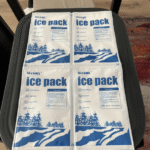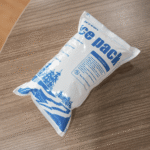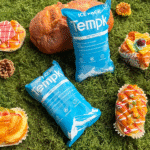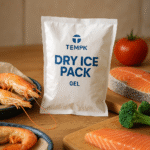Understanding cold chain expertise is crucial because temperature sensitive products—from vaccines and biologics to fresh food and specialty chemicals—must reach consumers without losing quality. This article answers how mastering temperature controlled logistics can help you build a resilient supply chain in 2025. Cold chain expertise touches every aspect of modern commerce and is projected to be a multi trillion dollar industry by the 2030s. على سبيل المثال, the global cold chain logistics market size accounted for USD 436.30 billion in 2025, with projections that it will increase to roughly USD 1,359.78 billion by 2034 (13.46 % CAGR). Such explosive growth underscores why companies of all sizes need to master cold chain know how.

Market outlook and growth drivers: Get up to date statistics and understand why cold chain expertise matters.
Key technological innovations: Learn how AI, blockchain, IoT sensors and portable freezers are transforming cold chain operations.
Best practices and real world scenarios: Discover practical tips and case studies to apply to your own supply chain.
Emerging trends and regulatory shifts: Stay ahead of geo political disruptions, sustainability goals and infrastructure upgrades.
2025 outlook and actionable guidance: Prepare your organization for the latest developments and move confidently into the future.
Why Cold Chain Logistics Is Booming
Market Size and Growth Drivers
The cold chain logistics sector is experiencing double digit growth. According to Precedence Research, the market was worth USD 436.30 billion in 2025 and is projected to jump from USD 496.80 billion in 2026 ل USD 1,359.78 billion by 2034. The Asia–Pacific region is expected to achieve the fastest growth, مع 14.3 % CAGR من 2025 ل 2034. This demand surge is driven by several factors:
Globalization of trade and rising international demand for fresh food, اللقاحات والبيولوجية. As more consumers expect year round access to fresh produce and speciality medicines, supply chains must ensure consistent temperature control.
Stringent safety regulations. Governments worldwide are tightening food safety and pharmaceutical handling standards. Compliance requires precise control and documentation, elevating the importance of cold chain expertise.
التقدم التكنولوجي such as automation, IoT tracking and AI analytics that improve visibility and efficiency.
Expansion of organized retail chains and e commerce platforms. Large grocery and convenience store chains are entering developing markets, increasing the need for refrigerated storage and transportation.
Post pandemic resilience. خلال الوباء, vaccines and biologics required ultra cold shipping and storage. Many companies adopted best practices that continue to boost demand.
These drivers contribute to a rapid market expansion that shows no sign of slowing. The refrigerated warehouse segment alone was valued at USD 238.29 billion in 2024, while the refrigerated transportation sector is expected to grow at a 13 % CAGR.
Practical Implications for Your Business
Understanding the scale of the industry helps clarify why investing in cold chain expertise is a smart strategy. A growing market means more competition and higher customer expectations, so companies must deliver flawless temperature controlled logistics to stand out. Whether you run a pharmaceutical company, manage a food retail chain or produce speciality chemicals, the following sections will help you develop best in class cold chain practices.
Market Data Snapshot
| Indicator | قيمة | تنبؤ بالمناخ | ماذا يعني لك |
| Global market size (2025) | دولار أمريكي 436.30 مليار | High growth expected | Demonstrates the scale and opportunity. |
| Forecasted size (2034) | دولار أمريكي 1,359.78 مليار | 13.46 % CAGR | Signals strong long term demand. |
| Pre cooling facilities value (2024) | دولار أمريكي 204.4 مليار | Investment needed | Highlights infrastructure upgrades and opportunities. |
| Dry ice technology share (2024) | 55.16 % | Growing | Points to a major role in frozen transport and packaging. |
| Refrigerated warehouse value (2024) | دولار أمريكي 238.29 مليار | Increasing demand | Encourages investment in modern storage facilities. |
The Pillars of Cold Chain Expertise
1. Mastering Temperature Control
Temperature control is the foundation of cold chain expertise. A cold chain is a supply chain that maintains a product within a specified low temperature range from production to consumption. It ensures quality, السلامة والامتثال التنظيمي. According to Precedence Research, cold chain logistics rely on refrigerated vehicles, insulated warehouses and IoT monitoring to keep goods within a precise temperature band.
Keeping goods at consistent temperatures requires understanding the thermal profiles of various commodities:
Chilled range (2 درجة مئوية إلى 8 درجة مئوية) for dairy, fresh produce and some vaccines.
Frozen range (–18 °C to –25 °C) for frozen foods and certain biologics.
Deep frozen (< -25 درجة مئوية) for specific pharmaceutical ingredients and high end seafood.
Ambient controlled (8 درجة مئوية إلى 15 درجة مئوية أو 15 درجة مئوية إلى 25 درجة مئوية) for products that require moderated temperatures.
Tips for effective temperature control:
Use calibrated temperature sensors and loggers at every stage of the supply chain.
Ensure pre cooling and pre conditioning of products and packaging before shipment.
Train staff on handling procedures to avoid thermal shock during loading and unloading.
Validate equipment regularly and maintain calibration certificates for audits.
2. Integrating IoT for Real Time Visibility
Investment in IoT (إنترنت الأشياء) enabled sensors is one of the most impactful ways to strengthen your cold chain. IoT sensors collect and share data in real time with minimal human interface, providing continuous temperature readings. When sensors detect unsafe temperature levels, they automatically alert users through texting platforms, email or apps. GPS enabled trackers provide location information, allowing you to monitor shipments and respond quickly to deviations.
Why IoT matters:
مراقبة في الوقت الحقيقي: Temperature deviations are spotted immediately, reducing product spoilage and regulatory violations.
الصيانة التنبؤية: Continuous data helps identify equipment malfunctions before they cause delays.
Enhanced data analytics: Historical temperature profiles guide product development and packaging improvements.
3. Leveraging Artificial Intelligence and Predictive Analytics
الذكاء الاصطناعي (منظمة العفو الدولية) transforms cold chain logistics. AI can optimize routes, shorten transit time and minimize fuel consumption by analyzing real time traffic and weather data. Predictive analytics can forecast temperature excursions based on historical data and recommend corrective actions.
تطبيقات عملية:
التوجيه الديناميكي: AI tools adjust delivery routes on the fly to avoid congestion and ensure timely delivery, reducing the risk of quality degradation.
Predictive temperature management: Systems forecast potential temperature excursions and alert the operations team to intervene early.
التنبؤ بالطلب: AI analyzes consumption patterns to optimize inventory levels, reducing waste and stockouts.
4. Ensuring End to End Traceability With Blockchain
Blockchain technology offers a secure way to record every step of a product’s journey. Each transaction or movement is stored in a tamper proof digital “block” that links to the preceding block, forming a chronological chain. This transparency builds trust by enabling all stakeholders—including manufacturers, regulators and consumers—to verify the authenticity and condition of goods.
Benefits of blockchain:
Enhanced security: Because each block is cryptographically linked, data manipulation becomes nearly impossible.
الامتثال التنظيمي: Real time data logs on temperature, humidity and transit time can be shared with regulators, ensuring compliance.
Consumer confidence: Traceability assures consumers that food or medicines are safe and have been handled appropriately.
5. Embracing Sustainable Technologies
Sustainability is increasingly central to cold chain strategies. Solar powered cold storage units provide a renewable energy source, reducing reliance on inconsistent power grids and lowering operational costs. الولايات المتحدة. Energy Information Administration reported that in 2024 commercial users paid 13.10 سنتا لكل كيلوواط ساعة for electricity, while commercial solar rates ranged between 3.2 و 15.5 سنتا لكل كيلوواط ساعة. By installing solar powered units, companies can significantly reduce energy costs and extend access to underserved regions.
Portable cryogenic freezers also support sustainability and accessibility. These units maintain ultra low temperatures between –80 °C and –150 °C, even in remote environments. Integrated real time tracking and warning systems ensure products remain within specification.
Key sustainability practices:
Adopt renewable energy sources, such as solar panels, to power warehouses and portable freezers.
Use recyclable or biodegradable insulated containers and reusable cold packs.
Implement route optimization to reduce fuel consumption and emissions.
Invest in energy efficient refrigeration systems and phase out refrigerants with high global warming potential (على سبيل المثال, HCFCs and HFCs).
Trends Shaping the Cold Chain Industry in 2025
Market Changes and Geopolitical Influences
Recent geopolitical unrest and “black swan” events have disrupted ocean transit and cold storage capacity. في 2024 and early 2025, trade relations and tariff changes caused delays and created pressure on stock availability, particularly in Europe. Despite these disruptions, industry experts say that the cold chain logistics sector has developed resilience. According to Maersk’s Strategy Development Manager, the market is prepared for changing demands and upcoming disruptions.
What you can do:
Diversify your transport routes and modes (طريق, air and sea) to mitigate risk.
Maintain buffer stocks and build flexibility into contracts with carriers.
Invest in end to end visibility tools to monitor shipments and react quickly to geopolitical shifts.
Stronger Visibility and Software Investment
The push for stronger visibility will continue in 2025. High quality, continuous data is essential for refrigerated products; Maersk reports that companies are investing heavily in software that improves supply chain visibility. Real time tracking and temperature monitoring help organizations mitigate disruptions and deliver better customer service.
New Product Categories and Consumer Demand
The rising popularity of plant based foods, gluten free products and organic produce creates new supply chain requirements. According to Bloomberg Intelligence, plant based foods could capture 7.7 % سوق البروتين العالمي من خلال 2030 with a value exceeding دولار أمريكي 162 مليار. These products are mainly produced by small and medium sized enterprises across Europe, Asia and North America. Many of these companies lack logistics experience and need partners with deep cold chain expertise.
نصيحة قابلة للتنفيذ:
Stay up to date on evolving food trends and adapt your portfolio accordingly.
Provide education and support to small suppliers to ensure product integrity.
Expand storage and distribution capacity for plant based and allergen free foods.
Infrastructure Upgrades and Sustainability
Many cold storage facilities were built 40–50 years ago and now struggle with inefficiency and outdated materials. في 2025, we will see continued investment in modernization, including automation, IoT integration and sustainability improvements. Regulatory pressure to phase out HCFCs and HFCs pushes operators to adopt environmentally friendly refrigerants.
Steps you can take:
Audit your facilities to identify energy inefficiencies and refrigerant compliance issues.
Plan upgrades that integrate automation for improved throughput and reduced labour costs.
Explore incentives or grants for sustainable equipment to offset upfront costs.
Optimized Distribution Strategies
Cold chain distribution isn’t just about storage; proximity to customers and production areas is crucial. In international trade, export facilities need to be near harvests (ثمار, خضروات, fish or meat) while import facilities must handle inspection and energy checks. As demand grows, facilities are scaling up and automating to meet consumer expectations. New capacity building and automation will accelerate throughout 2025.
نصائح عملية:
Position warehouses strategically—close to ports, production areas and retail markets.
Integrate automation for faster throughput and improved product handling.
Build multi purpose hubs that support both export and import functions.
Technological Innovations Driving Cold Chain Excellence
Blockchain Use Cases Beyond Traceability
While blockchain is often associated with traceability, its potential goes further. It can facilitate smart contracts, which automatically execute payment or warranty actions when certain conditions are met (على سبيل المثال, temperature maintained within range). This reduces manual paperwork and speeds up cross border transactions. A blockchain enabled network also supports recall management. If a contamination or quality issue occurs, you can trace precisely which batch is affected and isolate it instantly.
Solar Powered Storage in Action
Solar powered cold storage units are particularly valuable in rural or off grid locations. In Southeast Asia, where electricity grids can be unreliable, solar units supply sustainable power for medicines and vaccines. These units lower energy costs and extend healthcare services to remote areas.
مثال العالم الحقيقي: In parts of rural India and Southeast Asia, solar refrigerated containers allow vaccines to be delivered to villages that previously had limited cold storage options. By leveraging solar panels and battery storage, these systems operate without diesel generators, cutting fuel consumption and emissions.
IoT Sensors Delivering Predictive Maintenance
Beyond basic monitoring, IoT sensors can detect vibrations, humidity and door open events. When combined with machine learning, these sensors predict equipment failures before they happen. على سبيل المثال, if a compressor exhibits unusual vibration patterns, maintenance teams can intervene before the temperature rises and product quality is compromised.
AI Driven Route Optimization and Predictive Analytics
AI tools go beyond simple navigation. They analyze traffic conditions, weather patterns and delivery schedules to create optimal routes that minimize fuel consumption and ensure timely delivery. Predictive analytics uses historical data to anticipate delays (على سبيل المثال, congestion near major ports) and recommend alternate routes.
فوائد:
Reduced transit time: Minimizes risk of temperature fluctuations.
Lower fuel costs: أقصر, more efficient routes reduce carbon footprint.
Enhanced reliability: Predictive models anticipate hazards and help maintain shipment integrity.
Portable Cryogenic Freezers and Ultra Low Temperature Transport
Biologics and cell therapies often require temperatures as low as –150 °C. Portable cryogenic freezers maintain these ultra low temperatures even in challenging environments. They are equipped with real time temperature tracking and warning systems, ensuring compliance and product safety during transit.
استخدام الحالة: Portable cryogenic freezers are essential for clinical trials, where small batches of experimental biologics need to be transported to remote trial sites. They support personalized medicine by allowing samples to remain stable throughout the journey.
Regulatory and Compliance Considerations
Food Safety Regulations
Countries around the world are tightening rules on temperature sensitive foods. Compliance often involves Hazard Analysis and Critical Control Points (تحليل المخاطر ونقاط المراقبة الحرجة) plans, product traceability and validated temperature control procedures. Regulators may require electronic record keeping of temperature logs and chain of custody documentation. Failing to meet these standards can result in fines, product recalls or damage to brand reputation.
Pharmaceutical Good Distribution Practice (الناتج المحلي الإجمالي)
للمستحضرات الصيدلانية, adherence to Good Distribution Practice (الناتج المحلي الإجمالي) إلزامي. GDP covers packaging, مواصلات, documentation and storage requirements to ensure drug efficacy. A key principle is maintaining a documented temperature range throughout distribution, supported by validated equipment and calibration records. Blockchain can simplify this documentation process and strengthen audit readiness.
Environmental Sustainability Regulations
Many countries are restricting or phasing out refrigerants with high global warming potential. على سبيل المثال, the Kyoto Protocol and subsequent amendments target HCFCs and HFCs. Operators must transition to alternative refrigerants and invest in more energy efficient systems. بالإضافة إلى ذلك, extended producer responsibility (إي بي آر) laws encourage the recycling of packaging materials. Sustainable packaging not only reduces waste but also demonstrates corporate responsibility.
Best Practices for Building Cold Chain Expertise
Develop Robust Standard Operating Procedures (SOPS)
Create clear, detailed SOPs for every stage of the cold chain—from pre cooling and loading to transportation, unloading and storage. SOPs ensure that staff follow consistent protocols, reducing variance and risk. Include guidelines for emergency situations (انقطاع التيار الكهربائي, equipment failure) and specify responsibility for each role.
Train and Empower Your Team
Human factors are critical. Train employees on handling procedures, مراقبة درجة الحرارة, emergency response and documentation. Encourage a culture of continuous improvement by soliciting feedback and incorporating lessons learned into updated SOPs.
Invest in Technology and Infrastructure
Modern cold chain operations rely on advanced equipment and software. Invest in refrigerated vehicles with precise temperature control, insulated warehouses, مستشعرات إنترنت الأشياء, AI powered route planning and real time monitoring platforms. Review your infrastructure regularly and upgrade outdated systems to improve efficiency and compliance.
Conduct Routine Audits and Validation
Regularly audit your processes, equipment and documentation. Validate that equipment maintains required temperature ranges and calibrate sensors. Conduct mock recalls to test traceability and response time. Use audit findings to refine SOPs and training programs.
Embrace Sustainability
Adopt a holistic approach to sustainability:
Transition to refrigerants with lower global warming potential.
Use renewable energy sources like solar for storage and transport.
Implement recyclable and biodegradable packaging solutions.
Optimize routes to reduce fuel consumption and emissions.
Foster Collaboration and Partnerships
Small and medium sized suppliers, particularly those producing plant based or specialty foods, may lack cold chain expertise. Partner with these suppliers to share best practices, provide training and help integrate them into your logistics network. Collaboration builds trust and enhances supply chain resilience.
2025 Outlook: What Lies Ahead
السنة 2025 will be a pivotal moment for cold chain logistics. The market is set to expand rapidly, driven by rising demand for vaccines, البيولوجيا, frozen foods and plant based products. في أثناء, الابتكار التكنولوجي, sustainability imperatives and geopolitical uncertainties will shape how companies operate.
الاتجاهات الرئيسية ل 2025
Resilience and flexibility: Companies will focus on designing resilient supply chains that can handle disruptions caused by geopolitical unrest or extreme weather.
Greater transparency: Continuous investment in IoT and software will deliver better visibility and data driven decision making.
New products and services: Plant based foods and personalized medicines will create new logistical challenges and opportunities.
ترقيات البنية التحتية: Older facilities will be modernized to meet stricter sustainability and efficiency standards.
Sustainability leadership: Companies that embrace renewable energy, eco friendly packaging and low GWP refrigerants will gain competitive advantage.
Expert Takeaways
دراسة حالة: A mid sized pharmaceutical distributor partnered with a technology provider to implement IoT sensors and AI driven route optimization. زيادة 12 شهور, they reduced temperature deviations by 35 %, cut fuel consumption by 15 % and improved on time delivery from 92 % ل 98 %. The investment paid for itself within a year and positioned the company as a preferred supplier in its region.
Market Insights and Forecast
Additional research from Fortune Business Insights estimates that the cold chain logistics market was valued at دولار أمريكي 293.58 مليار في 2023 and is projected to grow from دولار أمريكي 324.85 مليار في 2024 ل دولار أمريكي 862.33 مليار من قبل 2032, اعرض أ 13 % CAGR. Experts note that demand for cold chain solutions will remain strong due to demographic shifts and the growth of the pharmaceutical sector.
الأسئلة المتداولة
س 1: What are the biggest risks in cold chain logistics?
The major risks include temperature excursions, equipment failure, delayed shipments and regulatory non compliance. Mitigating these risks requires robust monitoring, contingency plans and ongoing training.
Q2: How can blockchain improve cold chain logistics?
Blockchain creates a tamper proof record of each transaction, ضمان التتبع من النهاية إلى النهاية. It improves regulatory compliance and facilitates faster recalls and transparent audits.
س 3: Are sustainable packaging solutions practical for cold chains?
نعم. Recyclable insulated containers, biodegradable wraps and reusable cold packs protect temperature sensitive products while reducing environmental impact. Sustainability is becoming an essential differentiator for companies.
س 4: What is the role of AI in cold chain management?
AI analyses real time traffic and weather data to optimise routes, forecasts demand and anticipates temperature excursions. It enhances efficiency, reduces fuel consumption and strengthens reliability.
س 5: Which industries benefit most from cold chain expertise?
الأدوية, التكنولوجيا الحيوية, الأطعمة والمشروبات, and specialty chemicals all rely heavily on temperature controlled logistics. E commerce grocery platforms, المستشفيات, diagnostic labs and dairy producers also benefit significantly.
ملخص وتوصيات
Cold chain expertise combines market insight, technology adoption, الامتثال التنظيمي والاستدامة. To succeed in this dynamic industry:
Invest in real time visibility. Deploy IoT sensors and predictive analytics to monitor shipments and anticipate problems.
Optimize your infrastructure. Modernize warehouses and refrigerated vehicles and phase out high GWP refrigerants.
Collaborate across the supply chain. Work with suppliers, carriers and customers to ensure standards are maintained.
احتضان الاستدامة. Use renewable energy, eco friendly packaging and route optimization to reduce emissions.
Stay agile. Prepare for geopolitical shifts, changing consumer trends and unexpected disruptions.
By following these strategies, you will build a resilient, efficient and future ready cold chain that supports your business objectives and benefits consumers worldwide.
حول Tempk
Tempk هي شركة تعتمد على التكنولوجيا ومتخصصة في الحلول اللوجستية للتحكم في درجة الحرارة. We offer a comprehensive portfolio of products—from insulated packaging and IoT sensors to AI enabled monitoring platforms—to help businesses maintain product integrity throughout their supply chain. Our team brings decades of cold chain expertise and works closely with clients across pharmaceuticals, الغذاء والمشروبات, and life sciences. We pride ourselves on delivering reliable, حلول مستدامة that protect your products and the planet.
دعوة إلى العمل
على استعداد لرفع سلسلة التبريد الخاصة بك? اتصل Tempk اليوم to schedule a consultation or request a demo of our innovative solutions. We’re here to help you build a resilient and sustainable supply chain for 2025 وما وراءها.























